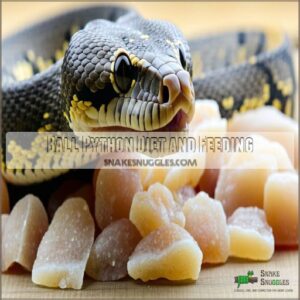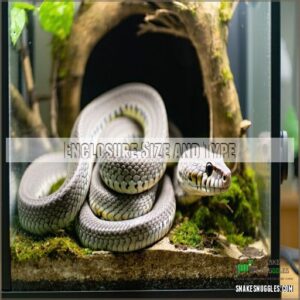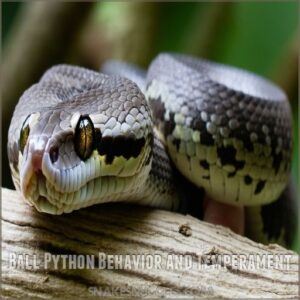This site is supported by our readers. We may earn a commission, at no cost to you, if you purchase through links.

You’ll need a spacious enclosure, maintaining a thermal gradient of 78-96°F. Use a substrate like aspen shavings, and provide plenty of hides.
Feed your python frozen-thawed rodents, sized appropriately for its body width. Juveniles eat every 7-10 days, adults less frequently.
Maintain humidity around 55-60%, increasing slightly during shedding. Regular cleaning is essential for your snake’s health.
Gentle handling is key – build trust slowly. Remember, a healthy ball python is a happy ball python! Want to learn more about creating the perfect ball python habitat? We’ll cover that next.
Table Of Contents
- Key Takeaways
- Ball Python Basic Care
- How to Care for a Ball Python
- Ball Python Diet and Feeding
- Ball Python Habitat Setup
- Ball Python Health and Hygiene
- Ball Python Handling and Taming
- Ball Python Shedding and Skin Care
- Ball Python Behavior and Temperament
- Ball Python Lifespan and Growth
- Ball Python Care and Maintenance Costs
- Frequently Asked Questions (FAQs)
- Are ball pythons easy to care for?
- How often do you bathe a ball python?
- Do ball pythons like to be cuddled?
- What does a ball python need in its tank?
- How hard is it to take care of a ball python?
- What do you need to know before getting a ball python?
- What do ball pythons need in order to be healthy?
- What does a ball python need in a tank?
- How often should you hold a pet ball python?
- How often should a ball python be handled?
- Conclusion
Key Takeaways
- Set up a spacious enclosure with a thermal gradient (78–96°F), proper humidity (55–60%), and secure hides on both the warm and cool sides.
- Feed appropriately sized frozen-thawed rodents every 7–14 days, depending on the snake’s age, and avoid feeding live prey to prevent injuries.
- Handle your ball python gently 1–3 times a week, supporting its body fully, and avoid handling during shedding or immediately after feeding.
- Maintain a clean habitat with daily spot cleaning, monthly deep cleaning, and consistent hydration to promote your snake’s health and prevent illness.
Ball Python Basic Care
You’ll find that caring for a ball python isn’t as challenging as you might think, as these gentle reptiles need just four key elements: proper housing, consistent temperatures, appropriate humidity, and regular feeding.
Your new snake will thrive in a well-maintained enclosure of at least 40 gallons, complete with two hiding spots and a temperature gradient ranging from 78 to 96 degrees Fahrenheit.
Housing and Enclosure Setup
Your ball python’s enclosure is their entire world, so getting it right matters.
For a comfortable habitat setup, choose a 40-gallon terrarium minimum – though bigger’s better, especially for females.
Line the snake enclosure with 3 inches of substrate like aspen shavings or cypress mulch.
Add two secure hide choices and a large water dish, creating different zones that’ll make your python feel right at home.
Temperature and Lighting Requirements
Getting the temperature and lighting just right for your ball python means creating distinct thermal zones in their habitat. Heat lamps positioned strategically help maintain a key thermal gradient.
Here are three key requirements:
- Keep the basking spot at 88-96°F using heat lamps
- Maintain ambient temperature at 78-80°F throughout the enclosure
- Provide 8-12 hours of simulated daylight cycle with UVB lighting
Humidity and Water Needs
Maintaining proper humidity levels can make or break your ball python’s health. A humidity range of 55-60% keeps their skin supple and supports healthy shedding. Place a large water bowl on the cool side of the enclosure, changing it daily to prevent bacterial growth.
| Humidity Need | Recommended Level | Maintenance |
|---|---|---|
| Daily Range | 55-60% | Monitor with hygrometer |
| Shedding Time | 65-70% | Increase misting |
| Dry Season | 50-55% | Light substrate misting |
Hiding Places and Enrichment
Beyond proper humidity, ball pythons thrive with multiple hiding spots and enrichment options.
Place at least two hide boxes on opposite ends of the enclosure to help your snake regulate its body temperature.
Mix up the environment with:
- Natural cork bark rounds and hollow logs for authentic hiding spots
- Sturdy climbing branches secured at different heights
- Live or artificial plants to create cover and visual barriers
- Various substrate depths for burrowing opportunities
The right mix of hiding places and enrichment keeps your ball python active, healthy, and secure in its habitat.
How to Care for a Ball Python
Successfully caring for a ball python requires understanding their unique needs and providing consistent attention to detail. Think of it as creating a cozy apartment that meets all their specific requirements for comfort and safety.
When you’re planning your ball python care routine, these essential elements deserve your focus: Set up a proper enclosure that meets recommended dimensions, such as at least 4 feet long, 2 feet wide, and 2 feet tall for adult ball pythons, which can be learned from a ball python cage setup guide.
Establish a regular cleaning schedule, including daily spot cleaning and monthly deep sanitization of the habitat.
Research different ball python morphs and find reputable breeders before making your purchase.
Create multiple hiding spots and enrichment opportunities.
Monitor your snake’s behavior daily, watching for signs of stress or illness that might require veterinary care.
Remember, ball python care isn’t complicated once you understand the basics, but attention to detail makes all the difference.
Ball Python Diet and Feeding
You’ll need to understand your ball python’s feeding requirements to maintain its health, as these snakes thrive on a simple diet of appropriately-sized rodents.
While feeding might seem straightforward, you’ll discover that timing, prey size selection, and proper handling techniques are essential for your snake’s long-term well-being.
Prey Size and Type
Your ball python’s prey selection directly impacts their health and happiness.
Choose pre-killed, frozen-thawed rodents that match your snake’s body width at its thickest point.
Here’s a quick guide to help you pick the right meal:
| Snake Age | Prey Type | Size Guide |
|---|---|---|
| Hatchling | Mouse Pinks | 1-2g |
| Juvenile | Adult Mice | 15-25g |
| Adult | Small Rats | 45-80g |
Never feed live prey – it can harm your snake.
Thaw frozen rodents in the fridge overnight, then warm to room temperature before feeding.
Feeding Frequency and Schedule
Now that you’ve got the right prey size, let’s talk about when to feed your ball python. The feeding schedule varies with age and season. Juveniles need more frequent meals to support their growth, while adults can go longer between feeds.
- Feed juvenile ball pythons every 7-10 days
- Adult feeding schedule: every 10-14 days
- Reduce feeding during winter months
- Skip meals during breeding season or shedding
Monitor your snake’s body condition and adjust the schedule accordingly. Some ball pythons might refuse food occasionally – that’s normal, especially during seasonal changes.
Pre-killed Vs. Live Prey
The debate between live and frozen-thawed prey sparks passionate discussions among ball python owners. While live prey might seem more natural, frozen-thawed rodents offer significant advantages for both snake and keeper.
When choosing frozen-thawed prey, it’s vital to follow proper preparation guidelines, such as defrosting overnight and warming to 98-100°F, as detailed in a thorough snake diet for ball pythons guide.
| Aspect | Frozen-Thawed Prey | Live Prey |
|---|---|---|
| Safety | No risk of injury to snake | Can bite and harm snake |
| Disease Risk | Parasites eliminated by freezing | May carry diseases |
| Convenience | Store long-term, feed on schedule | Requires frequent purchases |
| Cost | Bulk buying saves money | Generally more expensive |
Pre-killed prey eliminates injury risks, reduces stress levels, and guarantees a safer feeding experience. Most experienced keepers recommend frozen-thawed rodents as the best choice for maintaining your ball python’s health.
Water and Hydration Needs
A properly sized water bowl serves as both drinking station and soaking spa for your ball python‘s hydration needs. You’ll want a heavy-duty bowl large enough for your snake to curl up in, filled with fresh, dechlorinated water changed daily. Consider investing in a stainless steel bowl to maintain durability and hygiene.
- Watch for wrinkled, dull skin – it’s your python’s way of saying "I’m thirsty!"
- Monitor soaking habits – excessive soaking might signal health issues
- Keep humidity levels at 55-60% for ideal hydration
- Place the water bowl on the cool side to prevent unwanted humidity spikes
Supplements and Vitamins
Unlike other reptiles, ball pythons don’t typically need vitamin supplements when fed properly gut-loaded prey.
Mice and rats naturally provide balanced nutrition when they’ve eaten nutrient-rich foods before becoming prey.
However, if you’re noticing signs of deficiency like weak bones or irregular shedding, consult a reptile vet about adding calcium or vitamin D3 supplements to your ball python’s diet.
Ball Python Habitat Setup
You’ll need a spacious enclosure of at least 40 gallons with proper temperature zones to keep your ball python healthy and content.
Creating the perfect habitat isn’t complicated when you focus on the essentials: thermal gradient, appropriate substrate, hiding spots, and a large water dish for soaking.
Enclosure Size and Type
Setting up your ball python’s home starts with picking the right enclosure.
Adult ball pythons need a spacious tank measuring 48" x 24" x 24" – that’s about 75 gallons for males and 100 for females.
Your snake’s terrarium can be glass, PVC, or wooden, as long as it’s escape-proof and well-ventilated.
Glass tanks work great but tend to lose heat, while PVC enclosures hold humidity better.
Choosing The Right Substrate
Choosing your ball python’s substrate isn’t just about aesthetics – it’s essential for their health and comfort.
Aspen shavings, cypress mulch, and coconut fiber make excellent substrate options, providing natural burrowing opportunities while maintaining proper humidity.
Keep substrate depth at 3-4 inches, ensuring it’s clean and dry.
Avoid cedar, pine, or sand substrates as they can cause respiratory issues and skin irritation.
Creating a Thermal Gradient
To keep your ball python healthy, you need a thermal gradient.
Warm one side of the enclosure to 88-96°F for basking spots using heat lamps, leaving the cool side around 78-80°F.
Use temperature guns to verify accuracy.
Without proper ball python heating requirements, they can’t digest food well.
A balanced ball python habitat setup means consistent, safe temperatures.
Providing Hiding Containers
Once you’ve nailed the thermal gradient, focus on hiding spots.
Ball pythons are shy, so offer two hides—one on the warm side, one on the cool.
Use safe materials like plastic, wood, or ceramic. DIY options, like upside-down bowls, work too.
Make certain hide openings fit snugly without squeezing.
Proper hiding places help your snake feel secure, reducing stress in their habitat.
Ball Python Health and Hygiene
Keeping your ball python healthy means maintaining a clean habitat and recognizing early signs of illness.
With regular cleaning and proper care, you’ll guarantee your pet thrives for years to come.
Daily Cleaning and Maintenance
Keeping your ball python’s home clean is easy with daily maintenance.
Remove waste promptly for odor control and prevent bacteria buildup.
Invest in a reliable python enclosure cleaner to make cleaning a breeze.
Spot clean the substrate during checks and replace any soiled areas. Wash the water bowl daily with mild soap to maintain enclosure hygiene.
These small, consistent steps promote a healthy habitat and reinforce excellent ball python care habits.
Monthly Deep Cleaning
A monthly deep clean keeps your ball python enclosure safe and fresh.
Follow these essential steps:
- Remove the snake: Place it in a secure, temporary habitat.
- Sanitize surfaces: Use reptile-safe disinfectants to scrub the enclosure.
- Replace all substrate: Avoid reusing old bedding.
- Clean decorations: Soak hides and water dishes in diluted bleach, then rinse thoroughly.
Common Health Issues and Signs
Let’s get down to brass tacks: keeping a close eye on your ball python’s health is key. Watch out for common ball python illnesses, like respiratory problems or skin infections. Parasites are another worry. Unusual postures or appetite loss can signal trouble.
| Symptom | Possible Cause(s) | Severity | Treatment | Notes |
|---|---|---|---|---|
| Respiratory problems | Infection, poor ventilation | High | Vet visit, improved ventilation | Listen for wheezing or clicking sounds. |
| Skin infections | Bacteria, fungi, parasites | Medium | Topical treatments, vet consultation | Look for redness, swelling, or sores. |
| Parasites | Internal or external parasites | Medium | Medication, vet-recommended treatment | Regular fecal exams are important. |
| Unusual postures | Illness, injury, stress | Varies | Identify cause, address underlying issue | Observe behavior for changes. |
| Appetite loss | Illness, stress, shedding | Varies | Monitor, vet consultation if persistent | Note if the snake is still drinking water. |
Regular checkups nip problems in the bud, ensuring your scaly friend stays healthy.
Quarantine and Isolation Procedures
New snake quarantine helps keep your collection safe from parasites and illnesses.
Set up a separate enclosure to detect issues like fungal infections or bacterial concerns.
Follow these steps:
- Isolate the new ball python for 60-90 days.
- Watch for unusual behaviors or signs of illness.
- Schedule parasite checks to guarantee peak snake health.
Veterinary Care and Consultations
Regular veterinary care prevents ball python health issues before they spiral into problems.
Schedule preventative care checkups, especially with a reptile specialist, to catch concerns like respiratory infections early.
For emergencies, seek immediate help—don’t wait. Ethical breeders often suggest trusted vets.
Diagnostic tests may pinpoint snake health issues. Specialist referrals guarantee accurate treatment for complex ball python problems like parasites or unexplained lethargy.
Ball Python Handling and Taming
Handling your ball python properly helps build trust while ensuring its safety and well-being. Use gentle, confident movements, always supporting its body to avoid stress or injury.
Getting Your Snake Used to Handling
Getting your ball python used to handling takes patience and trust-building.
Start with slow introductions, letting them explore your hands. Use gentle handling techniques, avoiding sudden movements.
Positive reinforcement, like ending sessions calmly, helps foster ball python taming.
Remember, patience is needed—rushing can stress them.
Regular snake handling builds familiarity, encouraging gradual ball python socialization and developing a docile, trusting companion.
Supporting The Snake’s Body
When handling your ball python, always support its body evenly to prevent stress or injury, remembering that gentle handling from a young age can encourage socialization and a calm ball python temperament. Use two hands, letting it coil naturally without dangling. Respect its shy nature—don’t grab or squeeze.
- Cradle its middle and tail gently for balance.
- Maintain safe, comfortable positions aligned with its body.
- Monitor its movements to adjust support as it grows.
Avoiding Stress and Injury
Keep handling stress-free by offering safe spaces and using gentle handling techniques.
Avoid squeezing or sudden moves—slow introductions help build trust.
Recognize stress through ball python behavior, like defensive curling or striking, and pause interactions if needed. Overhandling increases ball python stress, so limit sessions to a few minutes.
Always confirm their proper enclosure prevents injuries and supports their well-being. Proper enclosure is vital for ball python well-being.
Washing Hands Before and After Handling
Safe snake handling starts with good hand hygiene. Always wash your hands before and after handling your pet ball python. This prevents disease transmission and parasite control.
Think of it as a vital part of ball python care and maintenance. Clean hands mean a healthy snake and a happy owner.
Proper snake handling techniques include this simple step. It’s a small thing that makes a big difference in preventing infections.
Ball Python Shedding and Skin Care
Shedding is a natural process for ball pythons, but it requires the right care to prevent issues like retained skin.
You’ll need to monitor humidity, provide rubbing surfaces, and guarantee proper hydration to keep their skin healthy.
Proper hydration is crucial for healthy shedding.
Recognizing Shedding Patterns
You’ve been handling your ball python comfortably, but pay attention to shedding frequency and shed quality as signs of health.
The ball python shedding process typically happens every 4-6 weeks.
Look for smooth, complete snake skin shedding. Stuck shed or unusual shedding could signal hydration or habitat issues.
Observe shed duration closely to spot problems early.
Providing Humidity and Moisture
Maintaining proper humidity levels is key for smooth shedding. Aim for 55-60% humidity using misting methods or damp moss in hides.
Use a hygrometer to monitor your ball python enclosure.
A large water bowl near the heat source helps boost moisture naturally.
Stick to humidity-friendly substrates like cypress mulch.
Small tweaks in your ball python habitat make shedding stress-free.
Offering Rubbing Surfaces
When your ball python sheds, rubbing surfaces are a shedding aid they’ll greatly appreciate.
You can find high-quality cork bark options, like those from a reputable supplier of cork bark, to help facilitate this process.
Place rough yet safe items like cork bark, driftwood, or sanitized rocks in their enclosure. These surfaces help loosen old skin without risking injury.
DIY options include textured logs or smooth branches. Strategically place them near ball python hides for easy access, encouraging natural behavior.
Soaking and Bathing Procedures
A short soak in lukewarm water (80-85°F) works wonders for shedding and hydration.
Limit soak duration to 20-30 minutes and monitor closely. Frequency depends on need—once a month or during difficult sheds.
This ball python care tip promotes skin health and wellness.
Always make certain water isn’t too deep, providing a safe, stress-free experience for your snake.
Ball Python Behavior and Temperament
Ball pythons are naturally shy but can show curiosity as they grow more comfortable in their environment.
By understanding their body language and mood, you’ll build trust and create a calm, rewarding relationship.
Understanding Body Language
Because understanding your ball python’s body language is key to successful handling, learn to recognize its subtle signals.
A relaxed ball python might display:
- Relaxed cues like a slow, steady movement.
- Curious actions such as gentle tongue flicking.
- Hunting behaviors, including a focused stare at potential prey.
These subtle cues help avoid unwanted stress and promote safe ball python handling.
Recognizing Stress and Anxiety
Stress in ball pythons shows through hiding habits, appetite changes, or defensive postures like curling into a ball. Pay attention to your snake’s usual behavior; sudden shifts may signal anxiety.
Extended hiding, hissing, or striking are clear anxiety cues. Monitor closely and adjust their environment to reduce stress.
| Stress Sign | Description | Possible Cause |
|---|---|---|
| Hiding Excessively | Rarely leaving hides | Improper enclosure setup |
| Reduced Appetite | Skipping meals | Temperature or humidity |
| Defensive Postures | Curling, hissing, or striking | Feeling threatened |
Encouraging Exploration and Activity
Encouraging your ball python to explore builds confidence and keeps them engaged. Offer enrichment ideas like safe climbing structures, natural décor, and multiple hiding spots in their terrarium. Use sensory stimulation by rearranging the habitat occasionally.
- Add sturdy branches or reptile-safe logs for climbing.
- Rotate hides and decorations for fresh experiences.
- Provide a shallow box filled with soft substrate for burrowing.
Dealing With Aggression and Biting
If your ball python strikes or bites, it’s often due to hunger, fear, or improper handling.
Recognize stress signs like hissing or defensive curling and avoid triggering aggression causes.
Use slow, confident movements and proven handling techniques.
For post-bite care, wash wounds thoroughly. Remember, ball python behavior typically improves with consistent, safe interactions and understanding their natural temperament. ball python behavior post-bite care
Ball Python Lifespan and Growth
Your ball python’s lifespan, with proper care, can reach an impressive 20 to 30 years or more.
These snakes grow steadily, with females often outpacing males.
reaching their full adult size within about three years.
Average Lifespan and Growth Rate
With proper care, a ball python’s lifespan often reaches 20-30 years, sometimes surpassing 40.
Growth factors vary—males typically grow 2-3 feet, while females reach 3-5 feet. Ball python growth slows after around three years but depends on health impact and diet.
Maturity ages differ, with males maturing at smaller sizes than females, reflecting unique ball python growth rates.
Factors Affecting Lifespan and Growth
A ball python’s lifespan and growth depend on genetics, diet, handling, environment, and disease.
Proper ball python care, such as maintaining ideal temperature and humidity levels, as outlined in the Ball Python Lifespan Guide (https://snakesnuggles.com/ball-python-lifespan/), supports health.
Poor ball python care and feeding can slow growth and shorten lifespan, while maintaining proper temperatures, humidity, and hygiene supports health.
Overhandling causes stress, lowering wellness.
Watch for signs of illness, as untreated issues can severely impact ball python health and wellness over time.
Monitoring Growth and Development
Understanding your ball python’s growth is key. Regularly weigh your snake using a gram scale and compare its weight to standard ball python weight charts. Note any growth spurts or deviations.
Size comparisons with other snakes of the same age are helpful, too.
These regular health checks, combined with monitoring your ball python feeding schedule, will help you catch potential problems early. This proactive approach guarantees your snake thrives.
Providing Optimal Care for Longevity
To give your ball python a long, healthy life, focus on these ball python care tips:
- Preventative healthcare: Schedule vet checkups; monitor for illnesses.
- Stress reduction: Provide cozy, quiet spaces.
- Dietary needs: Follow a ball python feeding guide.
- Breeding considerations: Avoid overbreeding females.
- Genetic factors: Choose a snake from reputable breeders prioritizing ball python health and wellness.
Ball Python Care and Maintenance Costs
Caring for a ball python involves both initial setup costs and ongoing expenses.
These costs can add up over time.
By budgeting wisely, you’ll guarantee your snake thrives without unexpected financial stress.
Initial Setup and Equipment Costs
Setting up a ball python enclosure costs around $200-$500.
You’ll need an appropriately sized ball python terrarium, sturdy substrate (like aspen shavings or cypress mulch), a water dish, and supplies for heating and lighting.
A proper ball python tank setup includes heat mats or ceramic heaters, a thermostat to maintain temperatures, and hides for security.
Quality habitat investments guarantee comfort and health.
Ongoing Care and Feeding Expenses
A ball python’s ongoing care includes food costs, like frozen mice or rats, which run $2-$5 each, depending on size.
Substrate replacement happens monthly, averaging $10-$20.
Expect occasional enclosure upgrades, adding $50-$100 every few years.
Factor in unexpected expenses, like heat mat replacements or humidity tools.
Ball python feeding and maintenance remain economical compared to most pets.
Veterinary Care and Emergency Funds
Reptile vet visits aren’t frequent but essential.
An emergency fund or reptile insurance covers unexpected illness, injuries, or parasites like mites and ticks.
Ball python veterinary care includes treating respiratory infections and injuries, which can escalate without prompt attention.
Find a vet experienced with reptiles to avoid costly mistakes, and consider budgeting for annual veterinary check-ups that can cost between $50-$100, learn more about ball python monthly costs.
Regular checkups help catch issues early, saving stress and high vet costs later.
Budgeting and Planning for Care
Caring for a ball python is a rewarding, long-term commitment, and planning your budget upfront helps avoid surprises. Beyond the initial costs for the habitat and supplies, ongoing expenses like food and heating add up. Set aside an emergency fund for vet visits or unexpected issues.
- Initial costs: Habitat, supplies, and a healthy snake.
- Ongoing expenses: Feeding, heating, and maintenance.
- Emergency fund: Unexpected vet visits or habitat upgrades.
Frequently Asked Questions (FAQs)
Are ball pythons easy to care for?
Caring for a ball python is as smooth as a summer breeze.
With proper research and attention, it’s a low-maintenance pet.
It thrives on a simple diet, clean habitat, and gentle handling.
How often do you bathe a ball python?
You don’t need to bathe your ball python unless it has trouble shedding or gets particularly dirty.
Normally, it self-soaks in its water dish, so as long as that’s kept clean, baths aren’t essential.
Do ball pythons like to be cuddled?
Ball pythons aren’t “cuddly” like cats or dogs, but they tolerate gentle handling.
They prefer warmth and security, so they’ll coil around your arm or hand more for comfort than any affectionate reason.
What does a ball python need in its tank?
Think of a ball python’s tank like a cozy apartment—it needs a hide on each side (warm and cool).
A thermal gradient (78-94°F) is also necessary.
Proper humidity (55-60%), a water dish, and snake-safe substrate are also required.
How hard is it to take care of a ball python?
Caring for a ball python isn’t overly difficult; it’s manageable. They’re relatively low-maintenance, making them great pets for beginners who do their research. Just remember, they’re a long-term commitment!
What do you need to know before getting a ball python?
Before getting a ball python, know they live 20-30 years.
They need proper heating, humidity, and space, and eat mice or rats.
They’re low-maintenance but require commitment, patience, and regular care to stay healthy and thrive.
What do ball pythons need in order to be healthy?
Ball pythons need a warm enclosure with a temperature gradient, proper humidity (55-60%), and hiding spots.
Weekly feeding of appropriately-sized rodents is also necessary.
Regular cleaning, gentle handling, and monitoring for health issues guarantee longevity.
What does a ball python need in a tank?
Your ball python’s tank needs a warm hide, a cool hide, and a thermal gradient (78-94°F).
Consistent humidity (55-60%) is also necessary.
Substrate, such as aspen shavings, a large water dish, and climbing accessories are also needed.
A secure lid is required.
How often should you hold a pet ball python?
Handle your ball python 1-3 times a week, giving them time to adjust.
Avoid handling right after feeding or during shedding.
Be gentle, support their body fully, and let them explore at their pace.
How often should a ball python be handled?
Aim to handle your ball python 1-3 times per week, ensuring it’s calm and well-fed.
Avoid handling during shedding or within 48 hours of feeding to reduce stress.
Promote trust over time.
Conclusion
Remember, ball pythons can live for over 20 years!
Providing proper how to care for a ball python involves consistent effort.
Maintain the correct temperature and humidity; this prevents illness. Feed appropriately sized rodents, ensuring proper hydration.
Regular cleaning prevents bacterial growth.
Gentle handling builds trust, making your python a relaxed companion.
With diligent care, you’ll enjoy years of companionship with your healthy ball python. Consistent monitoring is key to their long-term wellbeing.






















